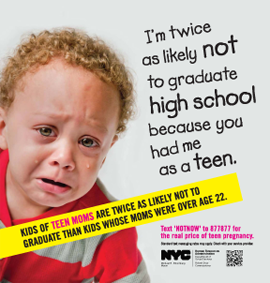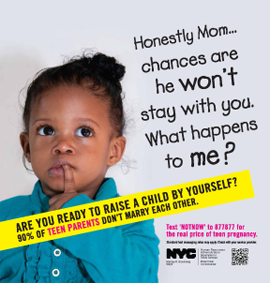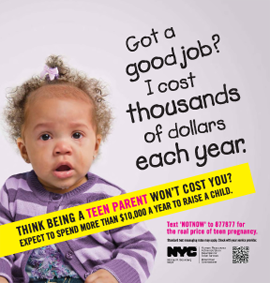
And finally, the piece de resistance. The number of commas in this ad alone suggests that quite a few conditions apply.
This one actually makes me the saddest, because it suggests that all of our teens in NYC have access to high quality education and good job prospects. It suggests that these teens are simply forgoing all of the opportunities that are waiting for them and blowing it all by having a baby as a teen. Once again, we let ourselves and our politicians off the hook by blaming these teens for ruining their otherwise promising life trajectories, failing to acknowledge our responsibility as a society to provide them with meaningful alternatives and real opportunity.
It’s worth noting that the research they are drawing upon comes from a Brookings Institution book by Ron Haskins and Isabel Sawhill titled, “Creating an Opportunity Agenda.” The book focuses on how public policy should focus on expanding economic opportunity.
And here’s the actual research finding:
“those who finish high school, work full time, and marry before having children” have a 98% chance of not being in poverty.
Source: Haskins, R. & Sawhill, I. (2009). Our Vision: In Haskins, R. & Sawhill, I. (Eds.) Creating an Opportunity Society (p. 9). Washington D.C.: Brookings Institution Press.
Here’s another quote from the author description of the book:
“Some might think that America already presents people with lots of opportunity to get ahead. But it turns out that you need to pick your parents well. True, there is considerable mobility from one generation to the next, but the American economy tends to help those at the top stay there while making it difficult for those at the bottom to move up. Kids from families in the bottom 20 percent of the income distribution are nearly five times as likely to wind up in the bottom 20 percent as kids from families in the top 20 percent.”





